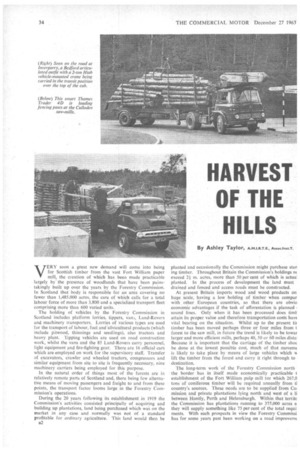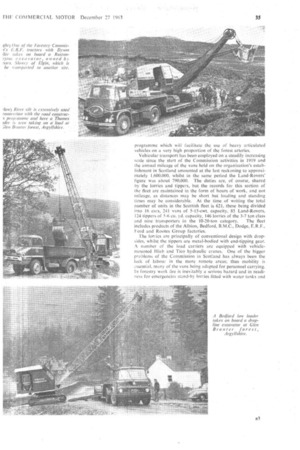HARVEST OF THE HILLS
Page 36

Page 37

Page 38

Page 39

If you've noticed an error in this article please click here to report it so we can fix it.
By Ashley Taylor, A.M.1.R.T.E., Assoc.Inst.T.
VERY soon a great new demand will come into being for Scottish timber from the vast Fort William paper mill, the creation of which has been made practicable largely by the presence of woodlands that have been painstakingly built up over the years by the Forestry Commission. In Scotland that body is responsible for an area covering no fewer than 1,485.000 acres, the care of which calls for a total labour force of more than 3,800 and a specialized transport fleet comprising more than 600 varied units.
The holding of vehicles by the Forestry Commission in Scotland includes platform lorries, tippers, vars., Land-Rovers and machinery transporters. Lorries of various types are used for the transport of labour, fuel andsilvicultural products (which include pitwood, thinnings and seedlings), also tractors and heavy plant. Tipping vehicles are used on road construction work, whilst the vans and the 85 Land-Rovers carry personnel, light equipment vid fire-fighting gear. There are 16 official cars which are employed on work for the supervisory staff. Transfer of excavators, crawler and wheeled tractors, compressors and similar equipment from site to site is frequently necessary, nine machinery carriers being employed for this purpose.
In the natural order of things most of the forests are in relatively remote parts of Scotland and, there being few alternative means of moving passengers and freight to and from these points, the transport factor looms large in the Forestry Commission's operations.
During the 20 years following its establishment in 1919 the Commission's activities consisted principally of acquiring and building up plantations, land being purchased which wai on the market in any case and normally was not of a standard profitable for ordinary agriculture. This land would then be B2
planted and occasionally the Commission might purchase stan ing timber. Throughout Britain the Commission's holdings tu exceed 24m. acres, more than 50 per cent of which is actua. planted. In the process of development the land must drained and fenced and access roads must be constructed.
At present Britain imports wood and wood products on huge scale, having a low holding of timber when compar with other European countries, so that there are obvio economic advantages if the task of afforestation is planned sound lines. Only when it has been processed does timk attain its proper value and therefore transportation costs have vital bearing on the situation. Whilst up to the present tit timber has been moved perhaps three or four miles from t forest to the saw mill, in future the trend is likely to be towat larger and more efficient mills, perhaps 40, 50 or 60 miles dista. Because it is important that the carriage of the timber shot. be done at the lowest possible cost, much of that moveme is likely to take place by means of large vehicles which v, lift the timber from the forest and carry it right through to destination.
The long-term work of the Forestry Commission north the border has in itself made economically practicable t establishment of the Fort William pulp mill tor which 267,0 tons of coniferous timber will be required annually from ti country's sources. These needs are to be supplied from Co. mission and private plantations lying north and west of a Ii between Huntly, Perth and Helensburgh. Within that territc the Commission has plantations running to 375,000 acres a they will supply something like 75 per cent of the total requi ments. With such prospects in view the Forestry Commissi has for some years past been working on a road improveme programme which will facilitate the use of heavy articulated vehicles on a very high proportion of the forest arteries.
Vehicular transport has been employed on a steadily increasing scale since the start of the Commission activities in 1919 and the annual mileage of the vans held on the organization's establishment in Scotland amounted at the last reckoning to approximately 1,600.000, whilst in the same period the Land-Rovers' figure was about 790,000. The duties are, of course, shared by the lorries and tippers, but the records for this section of the fleet arc maintained in the form of hours of work, and not mileage, as distances may be short but loading and standing times may be considerable. At the time of writing the total number of units in the Scottish fleet is 621, these being divided into 16 cars, 241 vans of 5-15-cwt. capacity, 85 Land-Rovers, 124 tippers of 5-6 cu. yd. capacity, 14 lorries of the 3-7 ton class and nine transporters in the 10-20-ton category, The fleet includes products of the Albion, Bedford, B.M.C,, Dodge, E.R.F., Ford and Rootes Group factories, The lorries are principally of conventional design with dropsides, whilst the tippers are metal-bodied with end-tipping gear. A number of the load carriers are equipped with vehiclemounted Hiab and Tico hydraulic cranes. One of the bigger problems of the Commission in Scotland has always been the lack of labour in the more remote areas; thus mobility is essential, many of the vans being adapted for personnel carrying. In forestry work fire is inevaably a serious hazard and in readiness for emergencies stand-by lorries fitted with water tanks and power-dliven fire pumps are located at strategic points. The dispersal of the fleet covers all forest areas of Scotland, control being exercised from the directorate offices in Edinburgh and administration being divided between the North, South, West and East Conservancies, Leading the engineering staff at the Edinburgh headquarters are Mr, D. M. Beaton, directorate engineer, and Mr. J. W. Blanc, directorate mechanical engineer. Mr. I. R. Christie is the directorate plant manager. In the North.Conservancy, Mr. A. J. Gaskin and Mr. R. Ross are conservancy engineer and mechanical engineer respectively. The main depot for this territory is Longman workshops, Inverness, with sub-depots at Torlundy and Fort William, Areas served include the counties of Inverness, Ross, Sutherland, Caithness and Nairn, together with the islands of Skye, Mull and Lewis.
West Scotland, with Mr. J. M. Halliday as conservancy engineer and Mr. F. C. Atkins as mechanical engineer, serves Argyll. Dunbarton, Perthshire and Stirling, West Lothian, Lanarkshire and parts of Fife, together with the islands of Arran and Islay. The main depots are at Glen Branter and Caimbaan, Argyllshire and at Aherfoyle, Perthshire, Mr. P. Malcohnson is conservancy engineer and Mr. H. Swin yard mechanical engineer in East Scotland, an-area covering Moray, Banff, Aberdeen, Angus, Perth, Kincardine and Fife, In this case the main depot is at Blackhall workshops, Banchory, Kincardineshire, there being sub-depots at Fochabers in Morayshire and Craigvinean in Perthshire. For the South Scotland territory the conservancy engineer is Mr. P. Walker and the mechanical engineer is Mr. W. Muddle. Through the medium of. the main depot at Durnfries and sub-depots at Creebridge, Newton Stewart, also Bennan, New Galloway, and Glentrees, Peeblesshire, operations throughout Dumfries, Galloway, Ayr, Peebles, Roxburgh, Berwick and Midlothian, are covered. The directorate workshops are situated at Chapelhall, Airdrie.
All vehicles are acquired centrally by the purchasing branch
of the Commison in London. Movements of the fleet regulated from conservancy offices with the delegation authority for local use to district officers, foresters and sur intendents of works. All the vehicles are subject to a nu tenance system which follows the lines generally accepted the road transport industry. In this connection holders vehicles, foresters, superintendents of works and other offic are responsible to the assistant engineers in, the conservam and all units are subject to regular inspection by the Comn sion's mechanical staff. A monthly analysis of -running cost: abstracted from the vehicle logs but figures in respect of repa tyres,. depreciation and similar items are calculated from ledgers on an annual basis. Individual plant history cards maintained at conservancy level.
The replacement policy for the fleet is related to the re; costs of a vehicle and to the hours mileage run. With the exception fire stand-by trucks and certain lc mileage platform units the gene order is equivalent to a fiveor year life. In addition to maintain the transport fleet the engineer department is responsible for tho ands of items of plant of gr variety. In round terms the value the vehicles and plant owned by Commission throughout Britain n be taken as approximately 14 m. even so, hiring of plant is necessary the busier periods. As emphasized earlier timber production is to some considerable extent a transport problem with the difference that in this case the producers must construct their own road system. starting from scratch, often without even the merest track on which to base their planning. Much of the Commission's actual transport is carried out on internal forest roads built by the organization's own road engineers and having gravel surfaces calculated to take loadings up to 25 tons. In many cases bridges must also be provided and these arc now being built to a standard that will enable them to sustain the passage of heavy-duty vehicles. Up to the start of last winter, 2.470 miles of road had been constructed or acquired by the Commission on its plantations in Scotland.
For the first 20 years of the Commission's life its primary work was directly concerned in establishing plantations. Whilst primitive tracks may be employed where timber is to be cleared once and for all, the intention with Commission forests in most instances is that they shall be 'subject to a continuing crop rotation, permanent roads therefore becoming an economic necessity. Thus by 1945 the institution of a road-building programme became necessary and this is now running at an annual level of 400 miles of new construction throughout Britain.
The technique of transport in connection with forestry work has progressed enormously during the past 15 years. At the beginning of that period the initial movement of timber was often by tractor and trailer, or ex-Army four-wheeldrive vehicle, to a processing plant on or adjacent to the site. Now, the trend is for timber to be carried in quantity to mills which may be situated considerable distances away. All this leads to a demand for large, articulated vehicles which will pick up at the extraction point and carry right through to the factory. In general terms it can he reckoned that roadways arc required at approximately furlong intervals, which means that no unreasonable distances will then be involved in towing the timber from the stump to the road. From each acre of plantation a final crop of between 100 and 200 trees may be expected, but at the outset something like 10 times this number will have been planted, the whole being subjected to repeated thinning-out processes, the thinnings being a valuable commodity in the market. After the final fellings fresh plantings are commenced.
As will be seen, roads may here be regarded in the light of the conveyor-lines of a huge production plant, and ideally the main arteries should be laid down before the forestry workers commence their activities. Quite early on a skeleton system representing about one third of the final requirement will be built, complete with all the necessary drainage, culverts and earthworks. At this stage, of course, traffic is light, being largely confined to fire-fighting vehicles in dry weather, so that the laying of main foundations may not take place until later. Gravel is invariably used for surfacing, as this material facilitates the later maintenance of the road by a mechanical grader.
Few users of transport can be responsible for a range of activities so comprehensive as those which are undertaken by the Forestry Commission—building the roads, carrying in personnel and raw materials, and moving the product to its final destination.
















































































